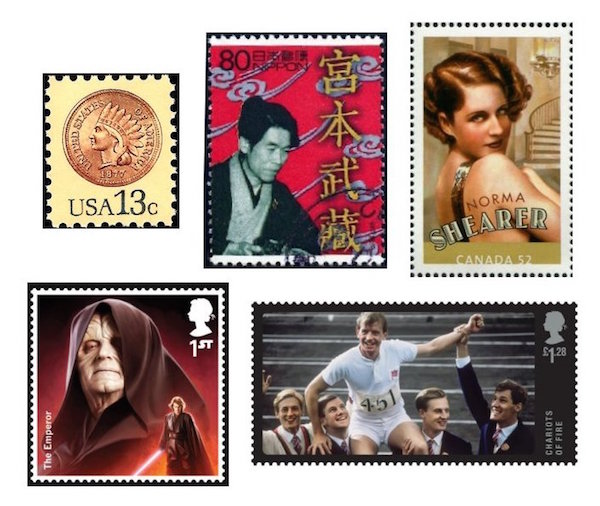The Arts on Stamps of the World — August 11
An Arts Fuse regular feature: the arts on stamps of the world.

By Doug Briscoe
Hans Memling (c1430 – 11 August 1494) was born and trained in middle Germany near Frankfurt, but was mostly active in Flanders, where he studied in the workshop of Rogier van der Weyden. Memling’s reputation extended to Italy, and the Medici purchased a number of his works. The United States used one of his madonnas, Virgin with Child between St. James and St. Dominic (1488–1490), for the Christmas stamps of 1966 and 1967. If you follow the provided link, note the carpet before the Virgin’s throne. It is a typical example of what has come to be called the “Memling carpet”, as he used this general type of design, probably from examples originating in Anatolia or Armenia, in a number of his paintings. Another Memling Madonna is the one taken from The Diptych of Maerten van Nieuwenhove (1487), shown in monochrome on the Belgian stamp in the middle of the top row. The Romanian stamp next to it reproduces Memling’s Portrait of a Reading Man (c1485). A similar arrangement follows in the second row: another Madonna, a portrait of Martin van Niuewenhove (1487), and Saint Benedict (1487). The final Memling row offers up the triptych Madonna and Child with Donors and an Angel (c1485) on a se-tenant set of three stamps from San Marino.

The American artist James B. Longacre (August 11, 1794 – January 1, 1869) has not been celebrated on a stamp of his own, but his work can be seen on a 1978 U.S. stamp recalling the Indian Head penny, which was minted between 1859 and 1909. It’s one of a number of coins designed by Longacre after he was named chief engraver to the Bureau of the Mint in 1844. Born in Pennsylvania, Longacre ran away from home at 12 (apparently a wicked stepmother situation) and found work with a Philadelphia bookseller. He was already very accomplished at drawing. Recognizing the boy’s talent, the bookseller apprenticed him to an engraver named George Murray. Longacre was named to the chief engraver position on the recommendation of John C. Calhoun and held the post until his death.
Eiji Yoshikawa (August 11, 1892 – September 7, 1962) was a Japanese historical novelist best known for updating Japanese classics such as The Tale of Genji. After working odd jobs in his youth, Yoshikawa began writing comic haiku and produced a novel that won a writing contest in 1914. He joined a newspaper and continued writing historical fiction, including his series about the early 17th-century swordsman Miyamoto Musashi. He also served as a war correspondent in China.
We conclude today’s rather brief piece with three actors. Canadian-born star Norma Shearer (August 11, 1902 – June 12, 1983) overcame her rather unphotogenic physical shortcomings—she regarded herself as “dumpy” with blunt hands and a cast in one eye—to work as an extra in the New York film industry. Irving Thalberg saw her in a 1921 movie and signed her to a contract in Los Angeles. She was a star by 1925. She won an Academy Award for The Divorcee in 1930 and went on to be nominated for her roles in four more films, including The Barretts of Wimpole Street (1934), Romeo and Juliet (1936), Marie Antoinette (1938). She is perhaps best known for her lead in The Women (1939).

Our two other actors happen both to be named Ian. Scottish actor Ian McDiarmid (think MacDermott, born 11 August 1944) is most celebrated for his portrayal of Senator/Emperor Palpatine in the Star Wars series (as seen on the British stamp), but he has had a long pedigree in the theater. He won a Tony in 2006 for his Broadway performance in Brian Friel’s play Faith Healer, and he has been active as a stage director as well as appearing in many films and television programs. (Coincidentally, the Scottish poet who used the pen name Hugh MacDiarmid also happens to have been born on August 11—no stamp. Born Christopher Murray Grieve, he lived from 1892 to 9 September 1978).
The other Ian is one we lost too soon. Best known for his role in Chariots of Fire (1981—see the stamp), Ian Charleson (11 August 1949 – 6 January 1990) was also a veteran Scottish stage actor who did much work in film and television. He died of AIDS at forty.
A graduate of the University of Massachusetts with a B.A. in English, Doug Briscoe worked in Boston classical music radio, at WCRB, WGBH, and WBUR, for about 25 years, beginning in 1977. He has the curious distinction of having succeeded Robert J. Lurtsema twice, first as host of WGBH’s weekday morning classical music program in 1993, then as host of the weekend program when Robert J.’s health failed in 2000. Doug also wrote liner notes for several of the late Gunther Schuller’s GM Recordings releases as well as program notes for the Boston Classical Orchestra. For the past few years he’s been posting a Facebook “blog” of classical music on stamps of the world, which has now been expanded to encompass all the arts for The Arts Fuse.
